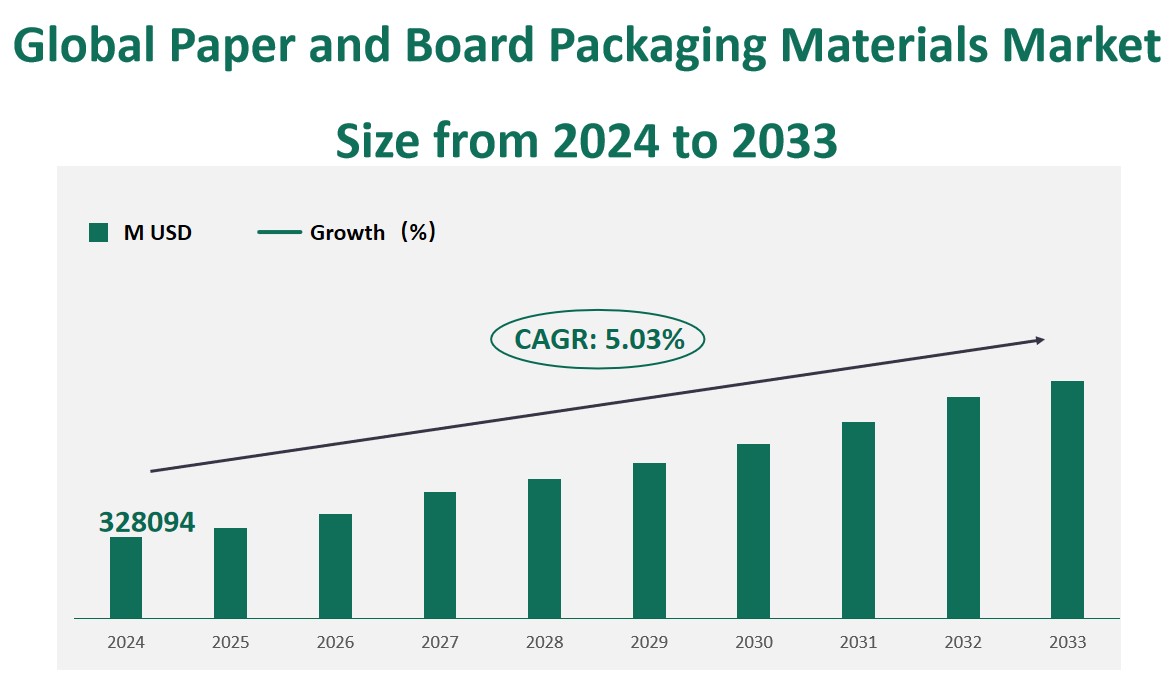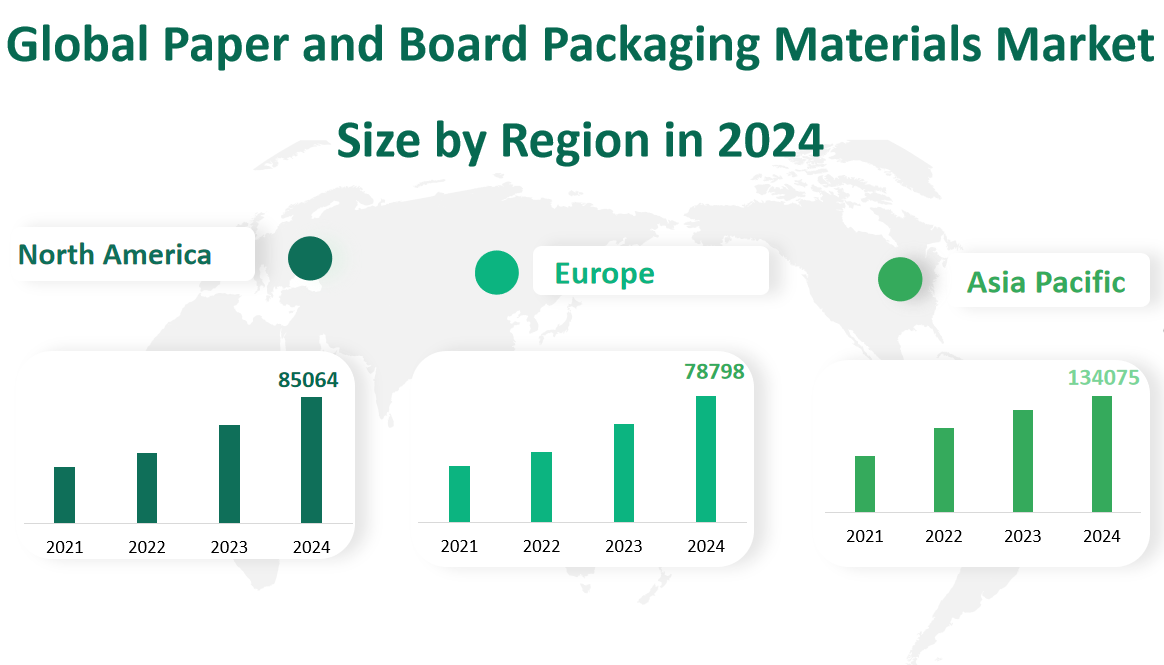1 Global Paper and Board Packaging Materials Market Insight Analysis
The global Paper and Board Packaging Materials market is expected to reach a total value of USD 328094 million in 2024, with a CAGR of 5.03% expected from 2024 to 2033.
Paper and board are sheet materials made from an interlaced network of cellulose fibers, derived from wood. Paperboard is thicker than paper with a grammage (area density) above 250 g/m2. They are the only widely used packaging material made from renewable sources. They can be made into rigid or flexible packages, depending on the type and amount of fiber used and how these fibers are processed during manufacturing.
Figure Global Paper and Board Packaging Materials Market Size (M USD) and CAGR (2024-2033)

2 Paper and Board Packaging Materials Market Growth Drivers and Restraints
Globally, the trend toward sustainability is growing, with consumers and businesses increasingly favoring environmentally friendly packaging solutions. Paper and paperboard materials are renewable and recyclable, which aligns with these trends, leading to increased demand.
The rapid growth of e-commerce has led to a surge in demand for packaging materials that protect goods during transportation. Paper and paperboard are often the first choice for e-commerce packaging due to their versatility and cost-effectiveness.
Innovations in digital printing, barrier coatings, and material science have improved the performance and functionality of paper and paperboard packaging. These advances can provide better protection, longer shelf life, and improved aesthetics.
As businesses operate globally, the demand for reliable packaging solutions that can withstand international shipping conditions has grown. Paper and paperboard materials meet these needs and facilitate global trade.
Many governments are implementing policies that favor the use of sustainable packaging materials, providing a boost to the paper and paperboard packaging industry.
Although paper and paperboard materials are renewable, their production can be resource-intensive and polluting, especially in terms of water use and chemical emissions. Stricter environmental regulations can limit production capacity and increase costs.
The cost of raw materials, such as wood pulp and recycled paper, may fluctuate due to factors such as climate change, trade policies, and supply chain disruptions, affecting the profitability of paper and paperboard packaging.
Plastics, metals, and glass offer alternative packaging solutions with different advantages, such as durability and barrier properties. These competitors challenge the market share of paper and paperboard packaging, especially in high-value segments.
In some markets, paper and paperboard packaging may be perceived as less premium compared to other materials. In addition, in mature markets, demand for paper and paperboard packaging may be close to saturation, requiring innovation to stimulate growth.
An economic recession may lead to a reduction in packaging spending, thus affecting the paper and paperboard industry. During an economic slowdown, companies may choose cheaper alternatives or reduce packaging to cut costs.
3 Technological Innovations in the Paper and Board Packaging Materials Market
Advances in digital printing technology have enabled greater customization of packaging, resulting in shorter runs and faster turnaround times. The technology also reduces waste and allows for on-demand printing.
Innovations in barrier coatings enhance the protective properties of paper and paperboard packaging, making them suitable for a wider range of products, including those sensitive to moisture, oxygen, and light.
Emphasis is being placed on developing packaging materials that are biodegradable, compostable, or made from recycled materials. At the same time, manufacturers are adopting cleaner production processes to reduce the environmental impact of packaging.
Integrating sensors and tracking technology into packaging allows for better monitoring of product freshness, temperature control, and supply chain transparency.
Automation of the packaging process improves efficiency and reduces labor costs. Robotics are being used for complex packaging tasks, increasing precision and speed.
4 Global Paper and Board Packaging Materials Market Size by Type
Corrugates are known for their strength and durability, making them ideal for shipping boxes and protective packaging. In 2024, the corrugates segment is projected to generate the highest revenue, reflecting its dominance in the market. The revenue for corrugates is estimated at $203001 million USD, accounting for 61.87% of the total market value. This significant share is attributed to the widespread use of corrugated materials in various industries, including e-commerce, retail, and manufacturing, where robust packaging is essential.
Folding cartons are versatile and lightweight, often used for consumer packaging in the food, beverage, and personal care sectors. The folding cartons segment is expected to contribute $93252 million USD in revenue in 2024, holding a market share of 28.42%. The appeal of folding cartons lies in their ability to be customized for branding and their suitability for automated filling lines, which drives their market share.
Flexible paper packaging is valued for its flexibility and adaptability, used in various forms such as bags, wraps, and pouches. The flexible paper segment is forecasted to generate $31840 million USD in 2024, capturing a market share of 9.70%. While this segment holds a smaller share compared to corrugates and folding cartons, it is expected to grow due to its convenience and the increasing demand for flexible packaging solutions in the food and retail industries.
Table Global Paper and Board Packaging Materials Market Size and Share by Type in 2024
|
Type |
Market Size (M USD) 2024 |
Market Share 2024 |
|---|---|---|
|
Corrugates |
203001 |
61.87% |
|
Folding Cartons |
93252 |
28.42% |
|
Flexible Paper |
31840 |
9.70% |
5 Global Paper and Board Packaging Materials Market Size by Application
Residential use refers to the packaging of daily necessities such as food, household cleaning products, and personal care items. In 2024, the residential use segment is projected to generate a revenue of $48188 million USD, capturing a market share of 14.69%. The growth in this segment is attributed to the increasing demand for eco-friendly and recyclable packaging materials in consumer goods, aligning with the global trend towards sustainability and environmental consciousness.
Commercial use encompasses a broader range of applications, including packaging for electronic products, cosmetics, pharmaceuticals, and food industries. The commercial use segment is expected to contribute significantly more revenue, with $279906 million USD in 2024, holding a dominant market share of 85.31%. This substantial share is due to the extensive use of paper and board packaging materials in various commercial sectors, where protection, branding, and transportation efficiency are critical.
Table Global Paper and Board Packaging Materials Market Size and Share by Application in 2024
|
Application |
Market Size (M USD) 2024 |
Market Share 2024 |
|---|---|---|
|
Residential Use |
48188 |
14.69% |
|
Commercial Use |
279906 |
85.31% |
6 Global Paper and Board Packaging Materials Market Size by Region
North America is anticipated to lead the market with a revenue of $85064 million USD in 2024, holding a market share of 25.93%. The region’s strong presence can be attributed to the high adoption of advanced packaging technologies and a well-established corporate culture that values efficient communication and supply chain management.
Asia Pacific follows with an expected revenue of $134075 million USD in 2024, capturing a market share of 40.86%. The region’s rapid industrialization and growing consumer base have led to an increased demand for packaging materials, making it a significant contributor to the global market.
Europe is projected to generate $78798 million USD in revenue in 2024, with a market share of 24.02%. The region’s mature market and technologically advanced infrastructure support the widespread use of paper and board packaging materials, particularly in the food and pharmaceutical industries.
South America and the Middle East and Africa are emerging markets with projected revenues of $19323 million USD and $10834 million USD, respectively, in 2024. These regions are experiencing growth due to increasing digitalization and the expansion of the middle class, which is driving demand for advanced packaging solutions.
Figure Global Paper and Board Packaging Materials Market Size (M USD) by Region in 2024

7 Global Paper and Board Packaging Materials Market Analysis by Major Players
7.1 International Paper Company
Company Introduction and Business Overview:
Established in 1898 and headquartered in the USA, International Paper Company is a global producer of fiber-based packaging and pulp products. The company operates in various industries, including e-commerce, food & beverage, grocery & retail, and personal care.
International Paper Company is engaged in manufacturing operations in the packaging and pulp industry, with a focus on corrugated and retail packaging, containerboard, paper bags, and various types of pulp such as fluff, paper grade, and specialty pulp.
Products:
The company offers a range of paper and board packaging materials, including corrugated packaging, which is known for its strength and sustainability, and is widely used in shipping and storage.
Market Performance in 2024:
International Paper Company, with a revenue of $15594 million USD and a gross margin of 25.63%.
7.2 WestRock
Company Introduction and Business Overview:
WestRock Co, established in 2015 and headquartered in the USA, is a provider of paper and packaging solutions. The company serves a global market with a wide range of containerboard and paperboard products.
WestRock manufactures and distributes folding cartons, bleached paperboard, coated recycled paperboard, retail displays, and pulp products. Its products are used in various industries, including beauty and personal care, beverage, commercial print, e-commerce, food, healthcare, home & garden, luxury packaging, media and electronics, retail, and tobacco.
Products:
WestRock’s product lineup includes CarrierKote® CUK paperboard, known for its strength and sustainability in wet and cold environments, and its excellent printability.
Market Performance in 2024:
WestRock, with a higher revenue of $20909 million USD and a gross margin of 26.18%.
7.3 Smurfit Kappa
Company Introduction and Business Overview:
Smurfit Kappa, established in 2005 and headquartered in Ireland, is a manufacturer of paper-based packaging solutions. The company’s products are primarily used for packaging purposes and are distributed mainly in Europe, America, and Africa.
Smurfit Kappa designs, produces, and supplies a variety of paper products, including corrugated packaging, solidboard, folding carton, Bag-in-Box, sack kraft paper, machine glazed (MG) paper, and graphic paper. The company also produces honeycomb and solidboard packaging.
Products:
Smurfit Kappa offers corrugated packaging solutions that are highly versatile and can be customized to fit various shapes and sizes, making them suitable for a wide range of products.
Market Performance in 2024:
Smurfit Kappa, though with a lower revenue of $10868 million USD, achieved a higher gross margin of 30.08%.





